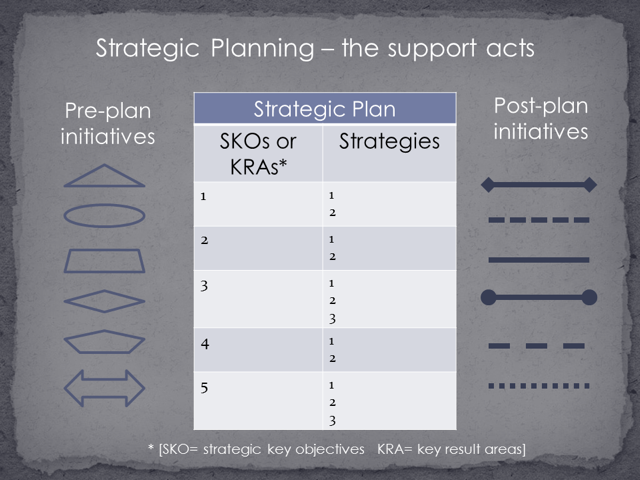Successful Strategy: The Essential Supporting Acts (Part One)

Behind successful firms is some form of successfully executed strategy. It can be short, punchy, even informal and, at a push, in someone’s head! The test is implementation and results, which always separates success from failure.
Strategy is not simply about ‘doing things better’; it is about achieving serious competitive advantage. It is high level, not operational or administrative.
The strategic plan itself is a relatively small part. It must be reinforced with many other supporting acts.
In this series of articles, aimed at small to medium firms starting out or wanting to upgrade their strategy process, I will outline some of these supporting exercises. If they are not undertaken it will seriously undermine a firm’s chance of getting results from strategy. Leaders will be challenged here – professionals like to jump straight into ‘doing stuff’: i.e. implementation.
The Strategy Document
The plan itself is often viewed as ‘the strategy’. In fact it is only a concise summation of key things that are sought, and, at a high level, how they will be achieved. Keep this document short and punchy. The strategy document must also be kept alive; it must be regularly updated.
But let’s consider some essential steps, ‘pre-strategy’.
Get your Partners Involved – from Inception
Get the partners involved upfront. This gets their support, shows them respect, generates ideas, identifies issues dear to them and improves chances of success and involvement down the line.
You must maintain their interest over a sustained period. They need to know how their role and contribution is valued and will make a difference. This is no easy task, but must be done. It requires real persistence. Keep your partners involved and interested but do not use too much of their time or bore them. This is a real test of leadership, as strategy is a journey not a destination and always a fine balancing act. It never truly has an ‘end’ and takes many twists and turns along the way.
Start by asking some searching open-ended questions based around the tried and tested SWOT (strengths, weaknesses, opportunities or threats) framework but also covering ‘core purpose’ items mentioned below. Also ask ‘What is going well?’ and ‘What could we do better?’ Challenge the partners to think about what in the firm:
- it should ‘stop doing’ (e.g. a loss-leading practice area);
- exhibits unrealised potential (e.g. taking advantage of existing client relationships);
- are substantial hidden expenses (e.g. less than full utilisation of expensive legal or support staff).
Do this ‘one on one’ or via a survey, but keep it short, punchy and relevant. Be sure to revert with survey outcomes or at least a summation of key points. Your job is to keep them interested and involved. By consulting, communicating and showing respect you do this.
Core Purpose or Strategic Intent
There is no single way to deal with concepts such as ‘core purpose’ but there should be a structure to it. I like to think of core purpose as clarifying your vision (what you want to be or where you want to go), what kind of firm you will be (e.g. ‘managed’ lockstep), your key cultural attributes (how we do things around here), your values (beliefs and understandings of what you will tolerate and not tolerate), what legal practices you will undertake or industry sectors you will focus on and the locations where you will choose to do this. Get these clear up-front and you will have set a very nice foundation for what is to come.
This is yet another test of leadership as this is arguably the most difficult thing around which to maintain interest. You will be met with all the usual scepticism, cynicism and sometimes downright objection. You will have to work your way through this.
Another thing I like to do early on is combine the values and cultural attributes exercise into ‘guiding principles,’ an idea I got from Norton Rose. Guiding Principles is a simple concept everyone can understand and it simply seems to make sense to professionals, which is half the battle. Otherwise, you will forever find partners or staff confused by concepts such as values and cultural attributes and what they mean. It is another little step in trying to keep things simple.
I look forward to communicating further in subsequent articles on this important topic!




